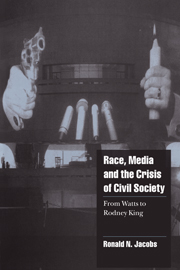1 - Race, media, and multiple publics
Published online by Cambridge University Press: 22 September 2009
Summary
On May 28, 1997, John Sengstakke died at the age of eighty-four. For six decades Sengstakke had been owner and editor of the Chicago Defender, the most important and most famous of all African-American newspapers. Sengstakke's death was a noticeable event in the world of American journalism; Brent Staples wrote a 1400-word obituary in the New York Times, calling Sengstakke the “Charles Foster Kane of the black press.” But Sengstakke's death was only the beginning of the story. Northern Trust Co., acting as executor of Sengstakke's estate, put the Defender up for sale in December 1997, in order to pay for a four-million-dollar estate tax bill. Contacting both African-American and white investors, the bank would only commit to seeking “fair value for the shareholders.” A crisis ensued within the black journalism community, with most insisting that the paper remain in African-American hands. In a front-page editorial, the Chicago Defender wrote that there were no plans to sell the paper, that the Sengstakke family was committed to maintaining the Defender, and that the reports about its sale were an “outright fabrication.” Several months later the family removed Northern Trust from its financial control of the estate, ending worries that the paper could fall into white hands.
- Type
- Chapter
- Information
- Race, Media, and the Crisis of Civil SocietyFrom Watts to Rodney King, pp. 19 - 30Publisher: Cambridge University PressPrint publication year: 2000
Accessibility information
- 1
- Cited by

